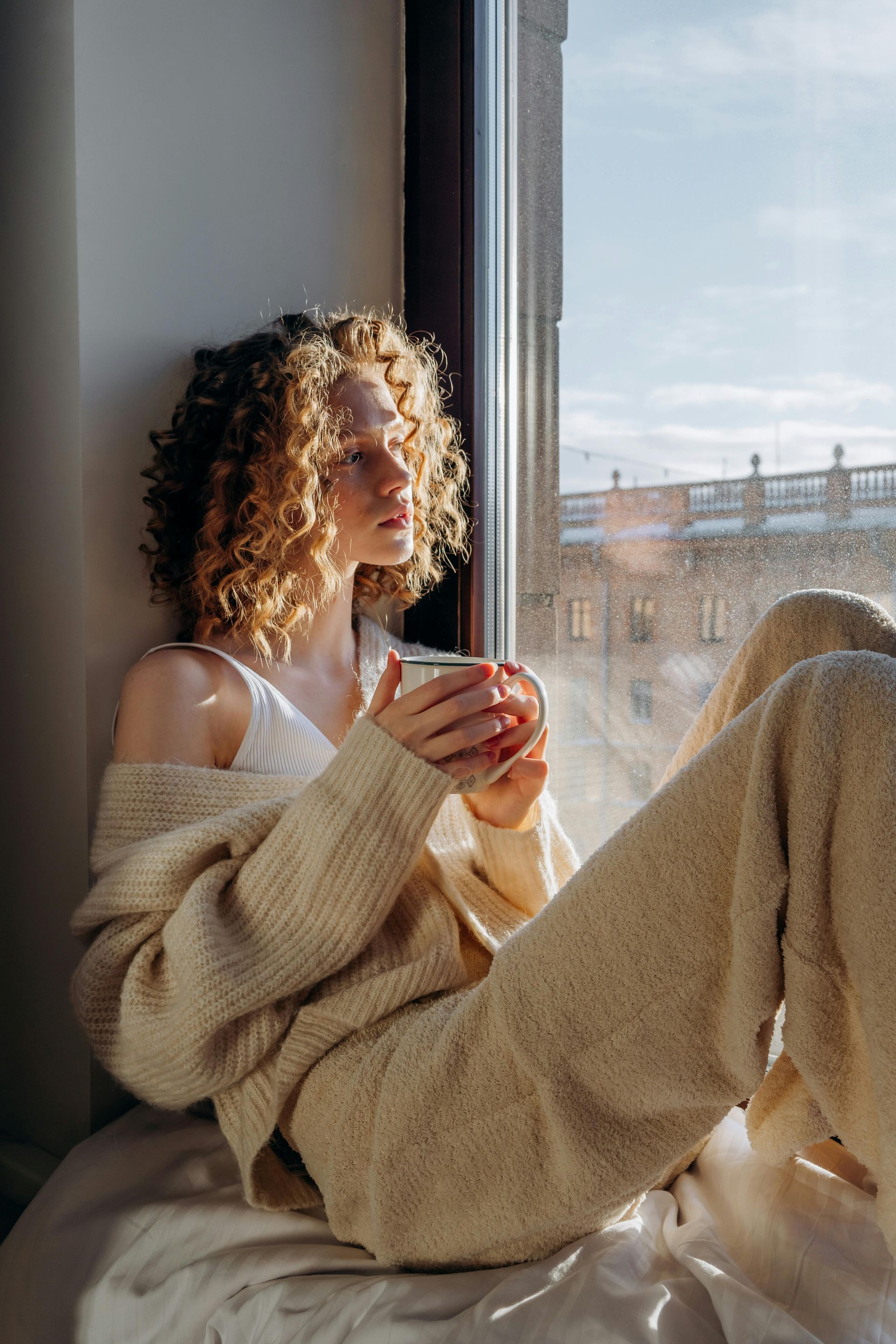Needing Rest Does Not Equal Weakness
If you’ve been in this place, it’s easy to think you’re weak or failing in some way. But that’s not true. Your nervous system is doing exactly what it was designed to do: protect you.
The problem is, it’s been working so hard for so long that it no longer knows how to
downshift into nourishing rest or relaxation.
What if the reason you struggle to slow down isn’t because you’re undisciplined or lacking resilience?
What if your brain has simply learned to see life as a series of threats?
Of course you feel disconnected, overwhelmed, and ready to quit!
There’s a part of you that’s always scanning for danger. It’s ancient and automatic. But there’s also a wiser part of you that can let you know, “It’s okay. You’re safe now.”
When you check in with yourself, does that part feel present and steady? Or does it feel like it’s limping along?
Giving yourself a break and resting
restores the connection between the ancient part and the wiser part.
That doesn’t mean you’ll never feel overwhelmed again, but it does mean you can start to teach your system a new way of being that doesn’t require constant vigilance just to get through the day.
What Happens When You Honor Your Limits
One of the most counterintuitive things I’ve learned is this that
when I honor my limits, they actually expand.
I used to think that if I stopped, I’d never start again. Or that everything would pile up behind me in an unmanageable crash.
In truth, sometimes it did—because I’d only stop when I was already at my breaking point. I’d push, and push, and push…until I flopped.
But collapsing isn’t the same as resting. Collapsing doesn’t replenish anything.
When I would inevitably get up and keep going because I
had to, I was operating from an even more depleted place.
I began to experiment with stopping sooner—when I noticed the first signs of pressure rising: tight shoulders, tunnel vision, that invisible push from behind. (It was hard!)
When I started to honor those signals and take a short break (or even just a breath),
I found I actually got more done in less time—even though it didn't
feel like.
When I practiced being deliberate and taking care instead of sacrificing my self at the Altar of Efficiency & Productivity, I was able to move through my day with clarity and focus. I cycled less between overdrive and collapse.
Rest became less of a guilty indulgence and more of a skill—something I could practice and get better at.
Yes, rest is a skill.
When It Feels Like You Should Handle It All
In our hustle culture, where doing more always seems better, it’s easy to feel uneasy or embarrassed about needing rest.
You might not call it shame, but it often shows up as guilt or self-judgment.
If you’ve ever felt that way, here’s what I’d say. “It’s not weak to need rest. It’s a requirement.”
Just like the earth has seasons—winter, spring, summer, and fall—you were never meant to stay in one season forever.
Spring
needs
winter.
Rest is what allows you to feel clear, present, and able to respond instead of react.
Listening to your body isn’t a sign that you’re failing. In fact, it’s the only way to sustainably grow your capacity.
You can learn to be nourished in ways that don’t just look like numbing out or collapsing.
You deserve rest that truly restores you. You deserve care and support that help you feel strong and able to flourish.
How Neuroscience-Based Practices Help You Release Pressure
If you’re wondering what you can do to
start shifting this pattern, this is where neuroscience-based practices—sometimes called neurosomatic exercises—come in. These are simple tools that help your brain and body relearn how to feel calm, safe, and present. As a certified Neurosomatic Practitioner, I use these techniques to help clients release chronic stress and reconnect with their natural resilience.
Neuro training uses simple, targeted exercises that stimulate your brain and body in ways that help you feel safer and calmer.
When you practice these drills:
- You release built-up tension (letting some of that stress out of the bucket!)
- You bring your system back to a calmer, more balanced place.
- You retrain your brain so it feels safe.
And over time, something even more powerful happens:
Your ability to stay calm and steady grows. At first, you may only have a small window where things feel manageable. But as you practice, that space gets bigger.
You begin to handle more of life without tipping into overwhelm or feeling like everything will fall apart.
You’re able to handle more things, but it
doesn’t feel like more pressure or stress.
This is what it means to
move away from survival outputs and toward performance outputs—clarity, steadiness, and a deeper trust in yourself.
Simple Neurosomatic Exercises to Try
I’ve had more than one client call these drills “scientific voodoo” when they were amazed at the immediate change in the way their system responded.
Take my client, Jane (name changed for privacy). Before working together, Jane was stuck in a constant state of overwhelm and exhaustion, barely managing to get through her days. After introducing these neuroscience-based practices, she noticed a remarkable shift—her energy stabilized. Where she had previously been shut down and unable to think, now she was able to focus and get more done than she had in
ages. That same tool helped her stay grounded and regulated the following week during a very challenging family situation.
While these tools can create powerful shifts, like they did for Jane, it’s also common to find that information alone isn’t always enough to create lasting change. If you’ve tried exercises like these before and felt some relief but still feel yourself looping back into old patterns, that doesn’t mean you’re failing or doing it wrong.
Often, our most entrenched stress responses are linked to deeper patterns and beliefs that take time, support, and reflection to unwind. Working with someone who understands nervous system dynamics can help you integrate these practices more fully and create sustainable change.
To get the most out of these exercises, learn to measure what works best for you. I’ve
created a video on the assess-reassess process.
You don’t have to do all of these—try one or two and notice how your body responds.
Straw Breathing
- Inhale fully into your belly through your nose for a count of two, then exhale slowly through a straw (or pursed lips) for a count of eight.
- As you breathe out, notice if your shoulders lower, your jaw softens, or your breath feels easier.
- Be sure all your air is exhaled by eight. Repeat 5–10 times, 3–4 times per day, eventually working up to 30 breaths over several weeks.
Scent Activation
- Find something you like the smell of—essential oil, coffee beans, lotion.
- Hold one nostril closed and gently inhale through the other for a few breaths. Reassess your range of motion. Repeat with the other nostril.
- Note if the smell was more intense on one side. You can do this drill 3–5 times per day on the side where you observed more ease.
Ab Belt
- Wrap an abdominal belt (or scarf) snugly around your midsection, ideally on your skin.
- Wear it for 3–5 minutes to start. Gradually extend the time you wear it.
- Take it off if you feel queasy, dizzy, irritable, cold, or clammy.
- Some people can wear it for many hours if their system allows.
An Invitation
If you’ve been living in the cycle of pushing past your limits,
ignoring your own depletion, and never feeling truly restored, please know you’re not alone.
You also don’t have to keep postponing the break you so deeply need.
You deserve rest that doesn’t leave you feeling guilty or feeling behind.
You deserve a space where you can learn, heal, and be witnessed.
The work we do together bridges science and self-trust to help you feel like you again.
Kathy Taylor
Nervous System and Confidence Coach
View my Bio
P.S.
When you’re ready to stop the burnout cycle and reconnect with your energy, here are some ways I can support you:
– Download my free guide to
Building Your Capacity. It offers simple, practical tips so you can start small and still have a big impact.
– Or, when you feel ready to go deeper,
book a discovery call so we can explore what kind of support would feel most nourishing for you.
Kathy gave me an owner's manual to my body and practical tools that create immediate results and significant improvements. The experience has given me hope and a way to reconnect with myself.
~Amanda Ferris, Business Consultant








